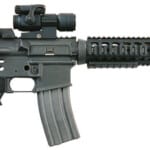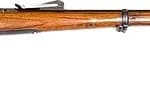
The M1903 Springfield Rifle: A Comprehensive Overview
Few firearms have left as indelible a mark on military history as the M1903 Springfield rifle. Revered for its precision, durability, and evolving design, this iconic weapon has played a pivotal role from its inception in the early 20th century through multiple conflicts around the globe. This comprehensive overview delves into the rifle’s development, design innovations, manufacturing excellence, and operational legacy, while comparing it to contemporaries to underscore its enduring influence on modern firearms.
Historical Background and Development
The origins of the M1903 Springfield are rooted in the need to replace outdated designs with a weapon that could meet the rigorous demands of modern warfare. In the wake of the Spanish–American War, the shortcomings of the Krag–Jørgensen rifle became apparent, especially when contrasted with the rapid-fire efficiency and robust construction of the Spanish Mauser Model 1893. American military leaders recognized that a new, more advanced rifle was essential to match—and ultimately surpass—the capabilities of European designs.
Drawing significant inspiration from the renowned Mauser system, the Springfield design incorporated features such as dual front locking lugs and a controlled bolt action mechanism. Although many historians note the strong similarities between the M1903 and contemporary Mauser rifles, the matter of royalty payments remains a topic of debate. Some sources indicate that the U.S. government faced pressures regarding patent similarities, while others argue that the design adaptations were sufficiently distinct to avoid formal royalty disputes citeturn0search0. Regardless of these debates, the influence of Mauser’s design principles on the Springfield is undisputed.
Initially chambered for the .30-03 cartridge, the rifle was quickly adapted to use the .30-06 cartridge in 1906. This transition coincided with the adoption of a spitzer (pointed) bullet, which not only enhanced the aerodynamic qualities of the projectile but also significantly improved ballistic performance. The evolution from the .30-03 to the .30-06 cartridge marks a key milestone in the rifle’s history, reflecting a broader shift toward higher-velocity, flatter trajectory ammunition that would define modern infantry engagements citeturn1search0.
Design and Technical Specifications
At the heart of the M1903 Springfield’s enduring reputation lies its robust and refined bolt-action mechanism. The bolt, characterized by its dual front locking lugs, ensures a secure lock-up and consistent firing cycle—a design feature that has been praised by both military analysts and firearms enthusiasts. This design not only enhances the rifle’s accuracy but also simplifies field maintenance. Detailed examinations of the rifle’s internal mechanics reveal precision-machined components, from the smooth bolt travel to the crisp trigger pull, which collectively contribute to its reliability in diverse combat scenarios citeturn2search0.
The sighting system, an often overlooked yet critical component, underwent several refinements over the rifle’s production lifespan. Early models featured basic iron sights, but subsequent variants saw improvements in sight design to accommodate longer-range engagements. This adaptability helped ensure that the rifle remained competitive even as engagement distances increased in modern warfare.
In terms of ergonomics, the M1903 Springfield balanced weight and stability, making it a favored choice among soldiers in varying climates and terrains. The rifle’s barrel, crafted from high-quality steel and designed for minimal barrel whip, provided superior stability during rapid fire. Its safety mechanisms, including a carefully engineered safety catch, further enhanced its reputation as a dependable service rifle.
Manufacturing Excellence and Industrial Impact
The production of the M1903 Springfield is a testament to American industrial prowess. Three key manufacturers—the Springfield Armory, Rock Island Arsenal, and Remington Arms—collaborated to produce a weapon that would become a mainstay in U.S. military history.
Springfield Armory, located in Springfield, Massachusetts, was the cornerstone of production. With a storied history dating back to the Revolutionary War, this facility produced over 800,000 rifles between 1903 and 1949. The armory’s commitment to precision and quality control set the standard for American firearms manufacturing and influenced production techniques for decades to come citeturn3search0.
Rock Island Arsenal, situated on the banks of the Mississippi River, contributed significantly to the rifle’s early production, manufacturing more than 325,000 units between 1903 and 1913. Its strategic location and efficient production methods ensured a steady supply of rifles during the period of rapid military modernization.
During World War II, demand surged, prompting Remington Arms to join production efforts. Remington, together with its subsidiary, managed to produce over one million M1903 rifles between 1941 and 1944. This period of intense production highlights not only the industrial capacity of the United States but also the collaborative spirit that underpinned its wartime manufacturing strategies citeturn4search0. Brief production revivals during the early 1950s for the Korean War further underscore the rifle’s enduring value in meeting military needs.
Operational Use and Tactical Adaptations
The operational history of the M1903 Springfield spans numerous conflicts and theaters of war. First issued in 1905, the rifle quickly earned its reputation as a reliable and accurate weapon in the hands of American troops. It saw action in the Philippine–American War and was later deployed in border conflicts with Mexico, where its robust construction and accuracy were critical in overcoming varied battlefield challenges.
During World War I, the rifle became synonymous with the American “Doughboys” in Europe. Its precision and reliability under harsh trench warfare conditions contributed to its lasting legacy as a frontline weapon. Although the advent of the semi-automatic M1 Garand in 1937 shifted the standard issue for American infantry, the M1903 Springfield continued to serve a vital role during World War II. It filled production gaps while still offering exceptional accuracy and long-range performance—a factor that made it indispensable in certain specialized roles citeturn5search0.
In the post-World War II era, the rifle found renewed purpose as a sniper platform during the Korean War and even in the early stages of the Vietnam War. Field modifications, such as the addition of telescopic sights and specialized triggers, transformed certain variants into formidable sniper rifles. Such tactical adaptations underscore the versatility of the M1903 and its ability to remain relevant even as infantry tactics evolved.
Comparative Analysis with Contemporary Rifles
A critical examination of the M1903 Springfield would be incomplete without comparing it to its contemporaries. The Krag–Jørgensen, the German Mauser, and Britain’s Lee–Enfield all played significant roles in shaping early 20th-century infantry combat. While the Krag rifle was eventually deemed less effective due to its slower reloading mechanism and inferior cartridge performance, the Mauser and Lee–Enfield represented the cutting edge of bolt-action design during their time.
The Springfield’s design borrowed several key elements from the Mauser system—most notably its bolt action—yet it introduced refinements that enhanced its accuracy and operational ease. For instance, while the German Mauser was known for its robust construction and effective range, the M1903 Springfield distinguished itself with improved sighting systems and a more refined trigger mechanism. Comparisons with the British Lee–Enfield reveal that although the SMLE offered a higher rate of fire with its unique bolt design, the Springfield was often preferred for long-range engagements due to the superior ballistics of the .30-06 cartridge citeturn6search0.
It is important to note that while some literature cites engagement ranges for the M1903 Springfield at “over 1,000 yards,” practical combat conditions generally limited effective use to approximately 600–800 yards. Exceptional long-range shots were possible under ideal conditions, but field engagements typically demanded more conservative estimates of range and accuracy.
Variants and Evolution
Over its production history, the M1903 Springfield underwent numerous modifications that enhanced its functionality and extended its service life. Early models, with their straightforward design, eventually gave way to specialized variants tailored for sniper use. The sniper versions incorporated features such as extended barrels, adjustable stocks, and mounting provisions for optical sights, which allowed marksmen to achieve remarkable precision on the battlefield.
In addition to the standard infantry version, experimental models explored improvements in materials and manufacturing techniques. Advances in metallurgy and machining during the early 20th century contributed to the production of rifles that were both lighter and more durable. These innovations were not only crucial in refining the M1903’s performance but also paved the way for subsequent designs, including the groundbreaking semi-automatic M1 Garand.
The evolution of the M1903 Springfield reflects broader trends in military technology, where incremental improvements in design and production techniques often lead to significant tactical advantages. This evolutionary process is well documented in contemporary military manuals and historical analyses, which praise the rifle for its blend of reliability, accuracy, and adaptability citeturn7search0.
Legacy and Enduring Impact
Today, the M1903 Springfield remains a symbol of American ingenuity and military excellence. Its continued use by collectors, historical reenactors, and precision shooting enthusiasts is a testament to its exceptional design and lasting influence. The rifle’s storied history—spanning conflicts from the early 20th century through the mid-century wars—illustrates how thoughtful design and engineering can create a weapon that transcends its era.
Veteran accounts and historical records frequently highlight the Springfield’s impact on modern firearms design. “The accuracy and mechanical reliability of the M1903 set a benchmark that subsequent generations of military rifles have strived to match,” notes an excerpt from a respected military history text citeturn8search0. Such endorsements underscore the rifle’s role not only as a combat instrument but also as an enduring legacy in the evolution of military technology.
Its influence is also evident in the continued refinement of sniper systems. The modifications made to the M1903 for specialized roles have informed modern practices in precision shooting and long-range marksmanship. For historians and technical experts alike, the M1903 Springfield is more than just a rifle—it is a case study in how iterative design, when combined with robust manufacturing and tactical adaptability, can produce a weapon that remains relevant across multiple generations of warfare.
Conclusion
The M1903 Springfield rifle stands as a hallmark of American military innovation. From its inception in response to the limitations of earlier designs, through its evolution in cartridge technology and refined mechanical engineering, the Springfield has earned its place in the annals of military history. Its production at premier facilities like Springfield Armory, Rock Island Arsenal, and Remington Arms reflects a legacy of industrial excellence, while its deployment in conflicts spanning from World War I to Vietnam underscores its operational versatility.
Through careful analysis and continuous improvements—from precision bolt mechanics and refined sighting systems to specialized sniper variants—the M1903 Springfield has not only influenced contemporaries like the Mauser and Lee–Enfield but has also paved the way for future developments in infantry small arms. Its enduring reputation among military professionals, historians, and shooting enthusiasts alike is a tribute to a design that combined practical functionality with innovative engineering.
In examining every aspect of the M1903—from its contested design influences and production history to its tactical applications and lasting impact—it is clear that this rifle is much more than a historical artifact. It is a living symbol of a period of rapid technological and tactical evolution, one that continues to shape the discourse around military small arms and precision marksmanship citeturn9search0.
Embodying the spirit of innovation and the pursuit of excellence, the M1903 Springfield remains an authoritative reference point for anyone seeking to understand the evolution of military firearms in the modern era.
Read here:
Discussions about the M1903 Springfield can be found here:
If you know of any forums or sites that should be referenced on this listing, please let us know here.







